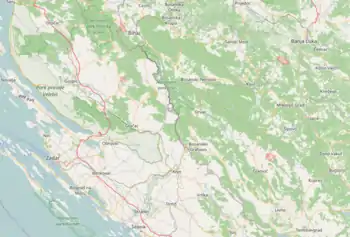Trubar massacre
The Trubar massacre was a massacre of Croatian civilians committed by local Serb rebels on 27 July 1941 in village Trubar in Drvar municipality Independent State of Croatia (modern-day Bosnia and Herzegovina).[1][2] It was one of a number of massacres in the southwestern Bosnian Krajina during the Drvar uprising and Eastern Lika.
| Trubar massacre | |
|---|---|
Locations of massacres in summer 1941 | |
| Location | Trubar, Drvar, Independent State of Croatia (modern-day Bosnia and Herzegovina) |
| Date | July 27, 1941 |
| Target | Croatian civilians |
Attack type | war crime, mass killing |
| Deaths | ~300 |
| Victim | Waldemar Maximilian Nestor |
| Perpetrators | Yugoslav Partisans and Chetniks |
Background
On 27 July 1941, a Yugoslav Partisan-led uprising began in the area of Drvar and Bosansko Grahovo.[3] It was a coordinated effort from both sides of the Una River in the territory of southeastern Lika and southwestern Bosanska.[4] It succeeded in transferring key NDH territory under rebel control.[4]
Incident
Parishioners of the Catholic parish in Drvar went on a pilgrimage near Knin on 26 July 1941. The massacre occurred in village of Trubar, 18 km from Drvar, where Chetnik rebels stopped a train on Vaganj station and separated pilgrims who were returning from Knin on 27 July. Murdered pilgrims, among whom was a German Roman Catholic priest, Waldemar Maximilian Nestor, were thrown into the pit of Golubnjača. Shortly afterwards massacres occurred in surrounding villages.[5][6] Some sources cite over 300 fatalities, yet many of the bodies that were thrown into deep caves, have yet to be fully exhumed.[7]
One of the witnesses of the massacre was a Partisan, Stevo Babić, who wrote that a group of rebels had executed train passengers at Golubnjača.[8] According to Croatian scholar Blanka Matkovich, the Yugoslav Partisans were responsible for the massacre.[1]
Exhumation
The Prosecutor's Office of Bosnia and Herzegovina announced in November 2015 that exhumations of bodies from the pit of Golubnjača were carried out and that these are the bodies of pilgrims killed in July 1941. Bodies were buried in priests' tomb in Banja Luka. Franjo Komarica, Bishop of Banja Luka, requested from the Office an investigation of the crime.[9][10]
See also
References
- Matkovich, Blanka (2017). Croatia and Slovenia at the End and After the Second World War (1944-1945). Warwick,UK: BrownWalkerPress. pp. 34–35. ISBN 9781627346917.CS1 maint: ref=harv (link)
- Dizdar, Zdravko & Mihajlo Sobolevski, „Prešućivani četnički zločini u Hrvatskoj i Bosni i Hercegovini: 1941-1945", Zagreb (1999)
- Tomasevich, Jozo (2002). War and Revolution in Yugoslavia: 1941 - 1945. Stanford University Press. p. 506. ISBN 978-0-8047-79241.
- Goldstein, Slavko (2013). 1941: The Year That Keeps Returning. New York Review of Books. p. 158. ISBN 978-1-59017-700-6.
- Čutura, Vlado. "Rađa se novi život na mučeničkoj krvi". Glas Koncila. Retrieved 30 December 2015.
- Vukšić, Tomo. ""Dan ustanka" - ubojstvo župnika iz Drvara i Bosanskog Grahova". Katolički tjednik. Archived from the original on 10 March 2016. Retrieved 30 December 2015.}}
- "27. srpnja 1941. – srpski ustanici izvršili strašan pokolj Hrvata u Drvaru i Grahovu".
- Babić, Stevo (1972). Drvar 1941-1945 – Sjećanje učesnika, II. sv. Drvar. pp. 207–208.
- "Drvar: Ekshumirani ostaci ubijenog župnika Waldemara Maksimilijana Nestora". hrsvijet.net. Retrieved 30 December 2015.
- "Nakon 73 godine sahrana drvarskog župnika". republikainfo.com. Retrieved 30 December 2015.
